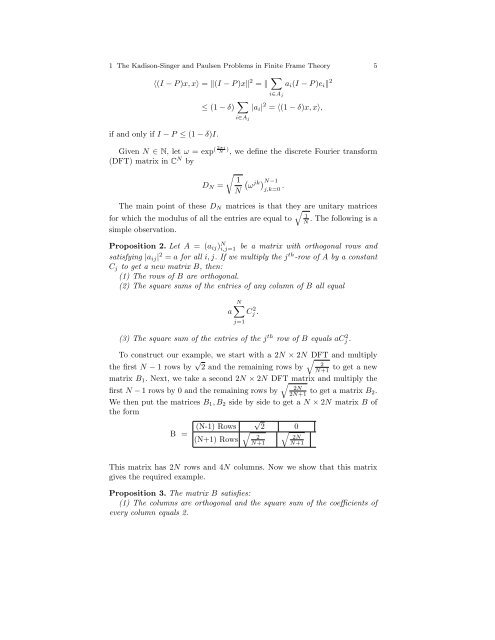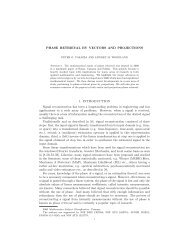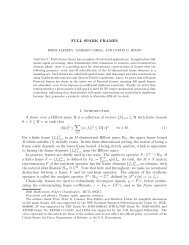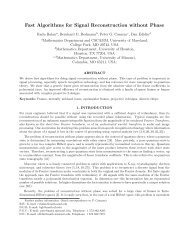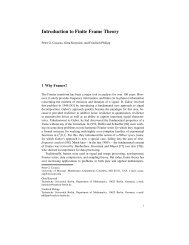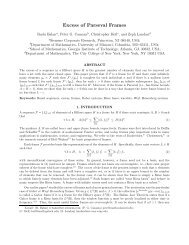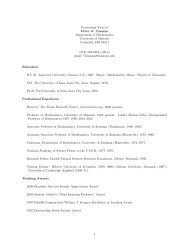The Kadison-Singer and Paulsen Problems in Finite Frame Theory
The Kadison-Singer and Paulsen Problems in Finite Frame Theory
The Kadison-Singer and Paulsen Problems in Finite Frame Theory
Create successful ePaper yourself
Turn your PDF publications into a flip-book with our unique Google optimized e-Paper software.
1 <strong>The</strong> <strong>Kadison</strong>-<strong>S<strong>in</strong>ger</strong> <strong>and</strong> <strong>Paulsen</strong> <strong>Problems</strong> <strong>in</strong> F<strong>in</strong>ite <strong>Frame</strong> <strong>The</strong>ory 5〈(I − P )x, x〉 = ‖(I − P )x‖ 2 = ‖ ∑i∈A ja i (I − P )e i ‖ 2if <strong>and</strong> only if I − P ≤ (1 − δ)I.≤ (1 − δ) ∑i∈A j|a i | 2 = 〈(1 − δ)x, x〉,Given N ∈ N, let ω = exp ( 2πiN ) , we def<strong>in</strong>e the discrete Fourier transform(DFT) matrix <strong>in</strong> C N byD N =√1N(ωjk ) N−1j,k=0 .<strong>The</strong> ma<strong>in</strong> po<strong>in</strong>t of these D N matrices is that they √ are unitary matrices1for which the modulus of all the entries are equal toN. <strong>The</strong> follow<strong>in</strong>g is asimple observation.Proposition 2. Let A = (a ij ) N i,j=1 be a matrix with orthogonal rows <strong>and</strong>satisfy<strong>in</strong>g |a ij | 2 = a for all i, j. If we multiply the j th -row of A by a constantC j to get a new matrix B, then:(1) <strong>The</strong> rows of B are orthogonal.(2) <strong>The</strong> square sums of the entries of any column of B all equalaN∑Cj 2 .j=1(3) <strong>The</strong> square sum of the entries of the j th row of B equals aC 2 j .To construct our example, we start with a 2N × 2N DFT <strong>and</strong> multiplythe first N − 1 rows by √ √22 <strong>and</strong> the rema<strong>in</strong><strong>in</strong>g rows byN+1to get a newmatrix B 1 . Next, we take a second 2N × 2N DFT √ matrix <strong>and</strong> multiply the2Nfirst N − 1 rows by 0 <strong>and</strong> the rema<strong>in</strong><strong>in</strong>g rows by2N+1 to get a matrix B 2.We then put the matrices B 1 , B 2 side by side to get a N × 2N matrix B ofthe formB = (N-1) Rows √2 0√ √2(N+1) RowsN+12NN+1This matrix has 2N rows <strong>and</strong> 4N columns. Now we show that this matrixgives the required example.Proposition 3. <strong>The</strong> matrix B satisfies:(1) <strong>The</strong> columns are orthogonal <strong>and</strong> the square sum of the coefficients ofevery column equals 2.


